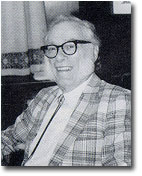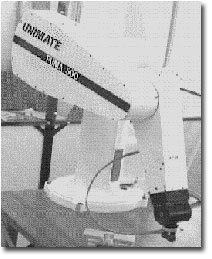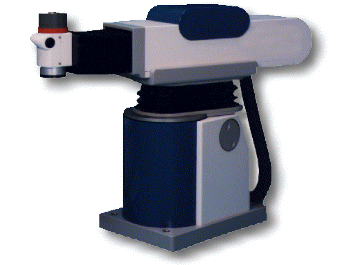|
|
|
|
|
|
|
| Learn about how the terms 'robot' and 'robotics' came about and get a brief introduction to the history of robotics. |
|
| Topics |
| Definition of a 'robot' |
| First use of the word 'robot' |
| First use of the word 'robotics' |
| Three Laws of Robotics |
| The First Robot 'Unimate' |
| Modern Industrial Robots |
| Benefits of Robots |
|
| Definition of a 'Robot' |
According to the Robot Institute of America (1979) a robot is:
"A reprogrammable, multifunctional manipulator designed to move
material, parts, tools, or specialized devices through various
programmed motions for the performance of a variety of tasks".
A more inspiring definition can be found in Webster. According to Webster a robot is:
"An automatic device that performs functions normally ascribed to humans or a machine in the form of a human."
|
|
| First use of the word 'robot' |
 The
acclaimed Czech playwright Karel Capek (1890-1938) made the first use
of the word ‘robot’, from the Czech word for forced labor or serf.
Capek was reportedly several times a candidate for the Nobel prize for
his works and very influential and prolific as a writer and playwright. The
acclaimed Czech playwright Karel Capek (1890-1938) made the first use
of the word ‘robot’, from the Czech word for forced labor or serf.
Capek was reportedly several times a candidate for the Nobel prize for
his works and very influential and prolific as a writer and playwright.
The use of the word Robot was introduced into his play R.U.R. (Rossum's Universal Robots) which opened in Prague in January 1921.
In R.U.R., Capek poses a paradise, where the machines initially bring
so many benefits but in the end bring an equal amount of blight in the
form of unemployment and social unrest.
The play was an enormous success and productions soon opened throughout
Europe and the U.S. R.U.R's theme, in part, was the dehumanization of
man in a technological civilization.
You may find it surprising that the robots were not mechanical in
nature but were created through chemical means. In fact, in an essay
written in 1935, Capek strongly fought that this idea was at all
possible and, writing in the third person, said:
"It
is with horror, frankly, that he rejects all responsibility for the
idea that metal contraptions could ever replace human beings, and that
by means of wires they could awaken something like life, love, or
rebellion. He would deem this dark prospect to be either an
overestimation of machines, or a grave offence against life."
[The Author of Robots Defends Himself - Karl Capek, Lidove noviny, June 9, 1935, translation: Bean Comrada]
There is some evidence that the word robot was actually coined by
Karl's brother Josef, a writer in his own right. In a short letter,
Capek writes that he asked Josef what he should call the artificial
workers in his new play.
Karel suggests Labori, which he thinks too 'bookish' and his brother
mutters "then call them Robots" and turns back to his work, and so from
a curt response we have the word robot. |
|
| First use of the word 'robotics' |
 The
word 'robotics' was first used in Runaround, a short story published in
1942, by Isaac Asimov (born Jan. 2, 1920, died Apr. 6, 1992). I, Robot,
a collection of several of these stories, was published in 1950. The
word 'robotics' was first used in Runaround, a short story published in
1942, by Isaac Asimov (born Jan. 2, 1920, died Apr. 6, 1992). I, Robot,
a collection of several of these stories, was published in 1950.
One of the first robots Asimov wrote about was a robotherapist. A
modern counterpart to Asimov's fictional character is Eliza.
Eliza was born in 1966 by a Massachusetts Institute of Technology
Professor Joseph Weizenbaum who wrote Eliza -- a computer program for
the study of natural language communication between man and machine.
She was initially programmed with 240 lines of code to simulate a
psychotherapist by answering questions with questions. |
|
| Three Laws of Robotics |
Asimov also proposed his three "Laws of Robotics", and he later added a 'zeroth law'.
Law Zero: A robot may not injure humanity, or, through inaction, allow humanity to come to harm.
Law One:
A robot may not injure a human being, or, through inaction, allow a
human being to come to harm, unless this would violate a higher order
law.
Law Two: A robot must obey orders given it by human beings, except where such orders would conflict with a higher order law.
Law Three: A robot must protect its own existence as long as such protection does not conflict with a higher order law.
|
|
| The First Robot: 'Unimate' |
 After
the technology explosion during World War II, in 1956, a historic
meeting occurs between George C. Devol, a successful inventor and
entrepreneur, and engineer Joseph F. Engelberger, over cocktails the
two discuss the writings of Isaac Asimov. After
the technology explosion during World War II, in 1956, a historic
meeting occurs between George C. Devol, a successful inventor and
entrepreneur, and engineer Joseph F. Engelberger, over cocktails the
two discuss the writings of Isaac Asimov.
Together they made a
serious and commercially successful effort to develop a real, working
robot. They persuaded Norman Schafler of Condec Corporation in Danbury
that they had the basis of a commercial success.
Engelberger started a manufacturing company 'Unimation' which stood for
universal automation and so the first commercial company to make robots
was formed. Devol wrote the necessary patents. Their first robot
nicknamed the 'Unimate'. As a result, Engelberger has been called the
'father of robotics.'
The first Unimate was installed at a General Motors plant to work with
heated die-casting machines. In fact most Unimates were sold to extract
die castings from die casting machines and to perform spot welding on
auto bodies, both tasks being particularly hateful jobs for people.
Both applications were commercially successful, i.e., the robots worked
reliably and saved money by replacing people. An industry was spawned
and a variety of other tasks were also performed by robots, such as
loading and unloading machine tools.
Ultimately Westinghouse acquired Unimation and the entrepreneurs' dream
of wealth was achieved. Unimation is still in production today, with
robots for sale.
The robot idea was hyped to the skies and became high fashion in the
Boardroom. Presidents of large corporations bought them, for about
$100,000 each, just to put into laboratories to "see what they could
do;" in fact these sales constituted a large part of the robot market.
Some companies even reduced their ROI (Return On Investment criteria
for investment) for robots to encourage their use. |
|
| Modern Industrial Robots |
 The
image of the "electronic brain" as the principal part of the robot was
pervasive. Computer scientists were put in charge of robot departments
of robot customers and of factories of robot makers. Many of these
people knew little about machinery or manufacturing but assumed that
they did. The
image of the "electronic brain" as the principal part of the robot was
pervasive. Computer scientists were put in charge of robot departments
of robot customers and of factories of robot makers. Many of these
people knew little about machinery or manufacturing but assumed that
they did.
(There is a common delusion of electrical engineers
that mechanical phenomena are simple because they are visible. Variable
friction, the effects of burrs, minimum and redundant constraints,
nonlinearities, variations in workpieces, accommodation to hostile
environments and hostile people, etc. are like the "Purloined Letter"
in Poe's story, right in front of the eye, yet unseen.) They also had
little training in the industrial engineer's realm of material
handling, manufacturing processes, manufacturing economics and human
behavior in factories.
As a result, many of the experimental tasks in those laboratories were
made to fit their robot's capabilities but had little to do with the
real tasks of the factory.
Modern industrial arms have increased in capability and performance
through controller and language development, improved mechanisms,
sensing, and drive systems. In the early to mid 80's the robot industry
grew very fast primarily due to large investments by the automotive
industry.
The quick leap into the factory of the future turned into a plunge when
the integration and economic viability of these efforts proved
disastrous. The robot industry has only recently recovered to mid-80's
revenue levels.
In the meantime there has been an enormous shakeout in the robot
industry. In the US, for example, only one US company, Adept, remains
in the production industrial robot arm business. Most of the rest went
under, consolidated, or were sold to European and Japanese companies.
In the research community the first automata were probably Grey
Walter's machina (1940's) and the John's Hopkins beast. Teleoperated or
remote controlled devices had been built even earlier with at least the
first radio controlled vehicles built by Nikola Tesla in the 1890's.
Tesla is better known as the inventor of the induction motor, AC power
transmission, and numerous other electrical devices. Tesla had also
envisioned smart mechanisms that were as capable as humans.
An excellent biography of Tesla is Margaret Cheney's Tesla, Man Out of Time, Published by Prentice-Hall, c1981.
SRI's Shakey navigated highly structured indoor environments in the
late 60's and Moravec's Stanford Cart was the first to attempt natural
outdoor scenes in the late 70's.
From that time there has been a proliferation of work in autonomous
driving machines that cruise at highway speeds and navigate outdoor
terrains in commercial applications.
Fully functioning androids (robots that look like human beings) are
many years away due to the many problems that must be solved. However,
real, working, sophisticated robots are in use today and they are
revolutionizing the workplace.
These robots do not resemble the romantic android concept of robots.
They are industrial manipulators and are really computer controlled
"arms and hands". Industrial robots are so different to the popular
image that it would be easy for the average person not to recognize
one. |
|
| Benefits |
Robots
offer specific benefits to workers, industries and countries. If
introduced correctly, industrial robots can improve the quality of life
by freeing workers from dirty, boring, dangerous and heavy labor. it is
true that robots can cause unemployment by replacing human workers but
robots also create jobs: robot technicians, salesmen, engineers,
programmers and supervisors.
The benefits of robots to industry
include improved management control and productivity and consistently
high quality products. Industrial robots can work tirelessly night and
day on an assembly line without an loss in performance.
Consequently, they can greatly reduce the costs of manufactured goods.
As a result of these industrial benefits, countries that effectively
use robots in their industries will have an economic advantage on world
market. |
|
| Sources:
General Internet Inc., Lawrence Kamm's website, CMU website, UW at
Madison website, RRG documentations and several other websites. |
|





